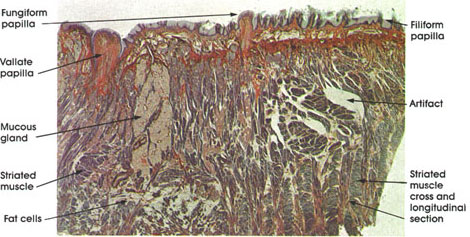

Plate 10.177 Tongue
Ronald A. Bergman, Ph.D., Adel K. Afifi, M.D., Paul M. Heidger,
Jr., Ph.D.
Peer Review Status: Externally Peer Reviewed

Human, Zenker's fluid, phosphotungstic acid hematoxylin stain, 5.6 x.
The epithelium of the dorsal surface of the tongue has three types of papillae: fungiform, filiform, and circumvallate (vallate).
The tongue is innervated by four cranial nerves, the fifth or trigeminal, the seventh or facial, the ninth or glossopharyngeal, and the twelfth or hypoglossal. The trigeminal nerve supplies the anterior two thirds of the tongue and is concerned with general sensibility. The facial nerve serves the same region but is concerned with taste or gustatory sensibility. The posterior one third of the tongue is innervated by the glossopharyngeal nerve serving both general and gustatory sensibility. The hypoglossal nerve is the motor nerve supplying the striated (somatic) skeletal musculature of the tongue. General sensibility refers to touch, pressure, pain, temperature, sense of position, and movement. Taste or gustatory sense, smell, sight, hearing, and awareness of head position and movement are termed the special senses.
Fungiform papillae: These are few in number, scattered among the filiform papillae. Larger than the filiform papillae. Wider at the top than at the base, resembling a mushroom, hence their name. Epithelial covering may possess taste buds.
Filiform papillae: Threadlike papillae much more numerous and smaller than fungiform papillae. Each papilla is made up of a thin core of vascularized connective tissue covered by a cornified stratified squamous epithelium. They do not have taste buds.
Vallate papillae: Large, surrounded by moats. Stratified squamous non-cornified epithelium covers a connective tissue core and contains taste buds. The serous or gustatory glands of von Ebner are closely associated with vallate papillae and empty into and flush the circumvallate groove.
Mucous gland: Pure mucous glands occur in the root and in the posterior part of the tongue. Their ducts open onto the dorsum of the tongue.
Striated muscle: The core of the tongue contains interlacing bundles of striated fibers that run in three planes: longitudinal, transverse, and vertical.
Fat cells: Part of the areolar fatty tissue in which muscles of the tongue are embedded.
Artifact: Spaces between muscle bundles are artifacts of fixation and/or embedding of the tissue prior to sectioning.
Next Page | Previous Page | Section Top | Title Page
Please send us comments by filling out our Comment Form.
All contents copyright © 1995-2025 the Author(s) and Michael P. D'Alessandro, M.D. All rights reserved.
"Anatomy Atlases", the Anatomy Atlases logo, and "A digital library of anatomy information" are all Trademarks of Michael P. D'Alessandro, M.D.
Anatomy Atlases is funded in whole by Michael P. D'Alessandro, M.D. Advertising is not accepted.
Your personal information remains confidential and is not sold, leased, or given to any third party be they reliable or not.
The information contained in Anatomy Atlases is not a substitute for the medical care and advice of your physician. There may be variations in treatment that your physician may recommend based on individual facts and circumstances.
URL: http://www.anatomyatlases.org/